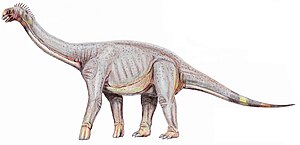Astrodon
| Astrodon | ||||||||||||
|---|---|---|---|---|---|---|---|---|---|---|---|---|

Life reconstruction by Astrodon johnstoni . |
||||||||||||
| Temporal occurrence | ||||||||||||
| Lower Cretaceous (Middle to Upper Aptium ) | ||||||||||||
| 121 to 112.9 million years | ||||||||||||
| Locations | ||||||||||||
|
||||||||||||
| Systematics | ||||||||||||
|
||||||||||||
| Scientific name | ||||||||||||
| Astrodon | ||||||||||||
| Leidy , 1865 | ||||||||||||
| Art | ||||||||||||
|
||||||||||||
Astrodon is a genus of sauropod dinosaur from the group of titanosauriformes , with Brachiosaurus was used and in the Lower Cretaceous lived North America. Like all sauropods, astrodon was a large, quadrupedal (four-footed) herbivore with a long neck and tail. The species Astrodon johnstoni was described as early as 1865 on the basis of teeth that were found in the Arundel Formation (middle to late Aptian ) in Maryland (USA). Other material from the Arundel Formation was described by Othniel Charles Marsh (1888) as Pleurocoelus ( Pleurocoelus nanus and Pleurocoelus altus ), although Gilmore (1921) suggested that all of these finds belong to a single species - with the name Astrodon havingpriority as he was the first to be forgiven. This opinion is supported by Carpenter and Tidwell (2005), who published the first comprehensive description of the remains - according to these researchers, Astrodon johnstoni is the only valid name. Nevertheless, there is still disagreement as to whether Pleurocoelus or Astrodon are used as the name for the sauropod should. In the following description, Pleurocoelus is considered to be a synonym of Astrodon .
features
Astrodon is known for a large number of bones, often found in isolation, which together cover the majority of the skeleton. Most of the finds come from young animals, which is shown, among other things, by the fact that the bones are small, that the bones of the brain skull (neurocranium) were not fused together and that the scars on the bones from muscle attachments were not very pronounced. Diagnostic features are found particularly on the vertebrae; the cervical vertebrae were short and very wide compared to Brachiosaurus and Sauroposeidon , which suggests a comparatively short neck. Another important distinguishing feature ( autapomorphy ) are the unusually large pleurocoels (lateral cavities) of the presacral vertebrae (the vertebrae in front of the sacrum , i.e. cervical and dorsal vertebrae), since many other representatives of the titanosauriformes show only weak pleurocoels. Some authors suspected that the pleurocoels were pronounced because the individuals found were mostly young animals - in fact, pronounced pleurocoels are a typical feature of juvenile sauropods, as it is e.g. B. at Camarasaurus can be observed. However, Carpenter and Tidwell (2005) note that the pleurocoeles of juvenile Camarasaurus were much smaller in relation to the vertebral body than those of Astrodon .
Find history and naming
Christopher Johnston named the genus Astrodon as early as 1859 on the basis of a tooth and a tooth fragment found near Bladensburg in Maryland, but did not establish a species name. It was not until 1865 that Joseph Leidy set up the epithet johnstoni in honor of Johnston and is listed as the author of the name Astrodon johnstoni according to the International Rules for Zoological Nomenclature (ICZN) . Astrodon is the first North American named sauropod and would have been the second North American named dinosaur ever, Johnston would have set up a species. Johnston chose the name Astrodon , which is made up of the ancient Greek words astron - "star" and odon - "tooth", as the tooth found was sawn in a ray shape.
John Hatcher discovered further sauropod material in 1887 and 1888, which Marsh (1888) assigned to two new species, Pleurocoelus nanus and Pleurocoelus altus , although the teeth of the two species that were found had strong similarities with the Astrodon teeth. Carpenter and Tidwell (2005, see sources) write: "As it was common for the time, Marsh did not refer any of his specimens to a previously named taxon, especially one created by someone else" (in German, for example: "Wie zu customary at that time, Marsch did not attribute any of his findings to a previously named taxon, especially if it was established by someone else ”). Later authors, with the exception of Salgado et al. (1995), assume that the finds belonged to a single sauropod species (e.g. Hatcher 1903, Lull 1911, Gilmore 1921 or Ostrom 1970). Carpenter and Tidwell (2005), who re-examined the entire material, confirm that the bones belong to only one species and consider Astrodon johnstoni to be the only valid name.
Marsh established the Pleurocoelidae family in 1898 , which should include Pleurocoelus . However, the diagnostic features of this taxon mentioned by Marsh were also found in other sauropods, which is why the family cannot be delimited and is therefore no longer accepted. Finds from Texas have also been assigned to the pleurocoelus in the past (Langston, 1974; Salgado and Calvo, 1997). Gomani et al. (1999) show differences in the vertebral anatomy to Pleurocoelus and differentiate the Texas sauropods from Pleurocoelus .
literature
- Kenneth Carpenter , Virginia Tidwell: Reassessment of the Early Cretaceous Sauropod Astrodon johnsoni Leidy 1865 (Titanosauriformes). In: Virginia Tidwell, Kenneth Carpenter (Eds.): Thunder Lizards. The Sauropodomorph Dinosaurs. Indiana University Press, Bloomington IN et al. 2005, ISBN 0-253-34542-1 , pp. 38-77.
Individual evidence
- ^ A b Gregory S. Paul : The Princeton Field Guide To Dinosaurs. Princeton University Press, Princeton NJ et al. 2010, 2010, ISBN 978-0-691-13720-9 , p. 203, online ( memento of the original of July 13, 2015 in the Internet Archive ) Info: The archive link was automatically inserted and not yet checked. Please check the original and archive link according to the instructions and then remove this notice. .
- ↑ Ben Creisler: Dinosauria Translation and Pronunciation Guide A. Archived from the original on November 6, 2011 ; accessed on August 11, 2014 .

